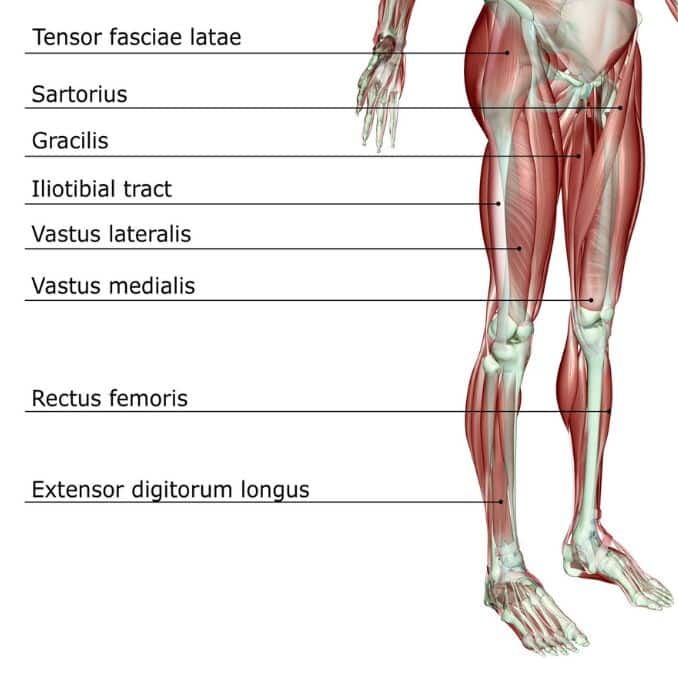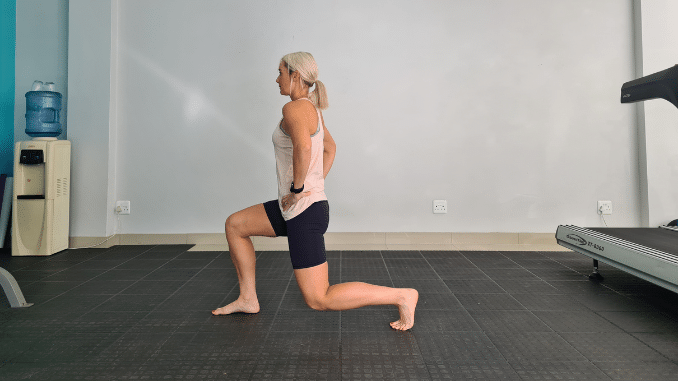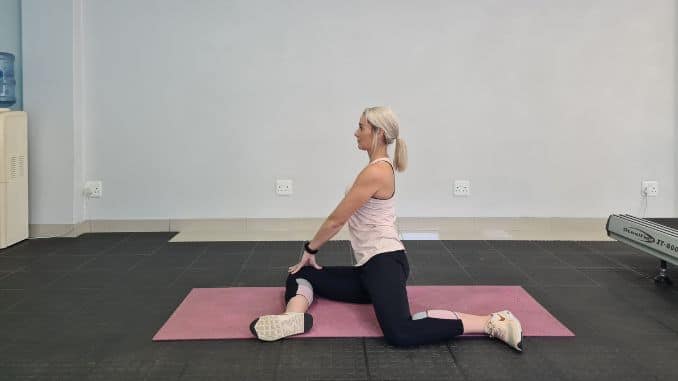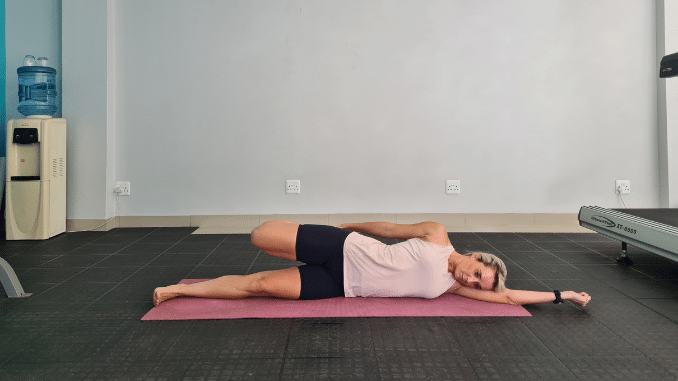
You may be wondering how tight hip flexors can cause headaches since the hips are located far from the head. But this can actually happen in some cases. There are several possible ways that a problem in one area of the body can affect another area of the body that is distal to it.
One example is a tight myofascial tissue that can cause symptoms such as pain, stiffness, and other dysfunctions in one area locally. But it can also cause similar symptoms to other areas of the body in what we call referred pain. This means that even in areas unrelated to where your tight myofascial tissue is, you can still experience symptoms of it. Aside from this, we also have another way called mechanical kinematic chains that could result in postural deviation compensation patterns. With this, your tight hip flexors can possibly cause your headache.
What are Mechanical Kinematic Chains?
The term “kinematics” comes from the Greek word “kine,” which means motion/movement. And mechanical kinematic chains refer to the links of interconnected chains that involve movement in our body. One example is the kinematic link of our lower extremities which involves the foot, leg, thigh, and pelvis. For our lower extremities to move, these kinematic links are needed.
On the other hand, for our upper extremities to move. The following kinematic links involved the hand, forearm, arm, and shoulder girdle. While the kinematic links of the axial body involve the pelvis, lumbar spine, thoracic spine, cervical spine, and head. This shows that the motion and posture of these different areas and structures affect the motion and posture of other links along the kinematic chain in our whole body to produce movement
The Mechanism Behind the Development of Tension Headaches
The hip flexors are a group of muscles located towards the front of the hip. It consists of 5 key muscles, the iliacus, psoas, pectineus, rectus femoris, and sartorius. Together, they help you move or flex the leg and knee toward your body.
These groups of muscles can become tight due to sitting for long periods of time, poor core strength, poor posture, sports that regularly engage the hip flexors in training, and others.
Tight Hip Flexors can Cause Excessive Anterior Pelvic Tilt
Excessive anterior pelvic tilt is one of the most common results of tight hip flexors. This refers to the pelvis that’s tilted or rotated forward. This occurs when your hip flexors are tight and become shortened, pulling your pelvis down. And your glutes and hamstring might be too weak to counteract the forward pulling, which causes a postural distortion known as excessive anterior pelvic tilt.
Excessive Anterior Pelvic Tilt can Cause Lordosis
Lordosis refers to the excessive inward curve of the spine, which is often the result of an excessive anterior pelvic tilt. This is because when the anterior pelvic tilt increases, the degree of the lordotic curve must also increase to compensate. This is also a postural distortion known as a lower cross syndrome. An excessive anterior pelvic tilt with a hyperlordotic lumbar spine.
1. Hyperlordotic Lumbar Spine:
Hyperlordotic Lumbar Spine refers to an excessive curvature of the lower spine or the lumbar region. It is also called “hollow back” or “swayback.” During the hyperlordotic curve of the lumbar spine, the superior surface of the body of L1 becomes less horizontal and more vertically oriented posteriorly. As the L5 sits on the sacral base, the T12 sits on the body of the L1. The lumbar curve is dependent on the posture of the pelvis, while the thoracic curve is dependent on the posture. To compensate for the excessive curvature of the lumbar spine, a hyperkyphotic thoracic spine is produced. This means there is also an excessive curvature of the upper spine or the thoracic region.
2. Hyperkyphotic Thoracic Spine:
Instead of the body of C7 sitting on the surface created by the body of T1, the superior surface of the T1 is more vertically oriented anteriorly in hyperkyphotic. As a result, the cervical spine is projected horizontally anteriorly. This causes the cervical spine to become hypo lordotic, or there is decreased curvature of the cervical spine. Another compensation it produces is the hyperlordosis of the head at the atlantooccipital joint to bring the eyes and inner ears leveled in what we call righting reflex.
3. Hypolordotic Lower/Middle Cervical Spine with Hyperextension at the Atlantooccipital Joint:
If the cervical spine is hypo lordotic or there is decreased curvature, and the head is hyperextended at the atlantooccipital joint. It causes the head to be projected anteriorly from the trunk. This postural distortion is also known as anterior head carriage or anterior head posture.
4. Anterior Head Carriage or Anterior Head Posture:
For your head not to fall forward, there must be a counterbalancing force of extension in your back. This is usually caused by the cervicocranial extensors located at the back of the neck. This includes upper trapezius, splenius capitis and cervicis, semispinalis cervicis and capitis, and levator scapulae. These muscles hold the head posteriorly. Now, if the head projects anteriorly to the trunk, these muscles work overtime and tighten.
5. Tight Posterior Neck Musculature:
These posterior neck muscles are attached to the head. When these are tight, they exert a constant isometric contraction in the head. This can result in constant pulling (tension) on the fascia of the scalp, which can cause symptoms like pain and irritation at the scalp and head or what is commonly known as “tension headache.”
This is how a tight hip flexor can cause tension headaches because of mechanical kinematic chains. It creates a domino-like effect in our bodies. However, not everyone who has tight hip flexors can experience tension headaches. Rather, a tight hip flexor can be a predisposing factor for tension headaches.
Exercises for Tight Hip Flexors
A. Half-Kneeling Hip Flexor Stretch
-
- Kneel on the floor, then bring your right leg in front so that your right thigh is parallel to the floor, your knee is bent at a 90-degree angle, and your foot is flat on the floor.
- Now put your hands on your hips, put your thumbs downward, engage your glutes, and tuck your pelvis under you.
- Then shift your weight forward until you feel a gentle stretch through your left thigh and groin.
- Hold this position for 30 seconds before returning to the starting position.
- Complete these tight hip flexors exercises with 3-5 repetitions, 1 set.
- Repeat on the opposite leg.
B. 90/90 Stretch
-
- Sit on the floor. Place your right leg in front of you and bend your knee at a 90-degree angle.
- Then extend your leg out to the side and bend your knee at a 90-degree angle.
- Place your hands on the sides of your right shin for balance.
- Slowly lean your chest forward until you feel a gentle stretch on your hips.
- Hold this position for 30 seconds before returning to the starting position.
- Complete 3-5 repetitions, 1 set.
- Repeat on the opposite leg.
C. Side-Lying Hip Flexor Stretch
-
- Lie on the floor on your left side with your knees bent. Make sure that your thighs and shins form a 90-degree angle.
- Now move your right leg behind you and hold the top of your right ankle using your right hand.
- Slowly pull your right foot with your right hand to bring it more behind you until you feel a gentle stretch in front of your thighs.
- Hold this position for 30 seconds before returning to the starting position.
- Complete these tight hip flexors exercises with 3-5 repetitions, 1 set.
- Repeat on the opposite leg on the opposite side-lying position.
Outlook
If you have been experiencing a headache for a while and the cause seems unclear, you should check with your Physical Therapist as it may be connected with other areas of the body, such as tight hip flexors. This can often be addressed with stretching and strengthening exercises for the tight hip flexors which can help you improve your overall health. It is always best to consult a doctor for proper treatment and management.






